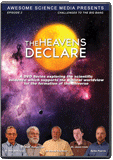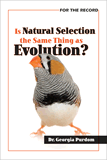News to Note, January 2, 2010
A weekly feature examining news from the biblical viewpoint
Still in the dark, microbes in training, Smokey the Chimp, and more!
This week:
- Still in the dark
- Microbes in training
- “Evolution” in action
- Smokey the Chimp
- The bird-snake dinosaur
- And Don’t Miss . . .
Did you miss it? Catch last week’s News to Note or any other!
1. Dark Matter Verified?
Dark matter: it’s mysterious, elusive (if it does exist), controversial—and now verified? Three weeks ago, we wrote, “Creationists have no inherent (i.e., biblical) reason to stand for or against the existence of dark matter. But as it is, dark matter is largely a speculation driven by big bang beliefs.” Our words were in comment on a news item that warned us that an upcoming announcement pertaining to the discovery of dark matter would be “of marginal statistical significance.”
2. Disinfectants Train Microbes
We’ve responded before to the claim that antibiotics cause microbes to “evolve” resistance (as if it didn’t exist before). Is the idea that disinfectants “train” microbes to become resistant any different? A team at the National University of Ireland studied the response of bacterium Pseudomonas aeruginosa to a disinfectant. P. aeruginosa commonly infects those already ill, resulting in opportunistic infections in hospital patients—so it is already a prime target of hospital disinfectants. But when subjected to “increasing amounts of disinfectant” in the lab, P. aeruginosa cultures developed resistance not only to the disinfectant but also to the antibiotic ciprofloxacin—even though the cultures were never exposed to ciprofloxacin.
3. Evolution Without Molecules-to-Man Evolution
If molecules-to-man evolution is a myth, why does evolution seem to explain some scientific observations? Or can mechanisms underlying fish “evolution” be understood without appealing to molecules-to-man evolution? In October 2008 we covered research into the “evolution” of fish known as cichlids in Africa’s Lake Victoria. New research from the same team further investigates cichlids, showing how “over 60 species of cichlid fish from Lake Malawi and Lake Victoria have adapted their visual sensitivity in response to specific ecological factors, including what they eat and the clarity of the water in which they swim.”
4. Chimpanzees and Fire
When it comes to fires, chimpanzees keep their cool. Does this “reveal a primitive hominid trait”? Iowa State University primatologist Jill Pruetz has drawn on personal experience in recent research that suggests chimpanzees “conceptualize” fire. When in Senegal in 2006, Pruetz followed a band of chimpanzees as they calmly worked their way around a savanna fire. “I was very surprised at how good they were at judging the threat and predicting the behavior of fire,” she explained. The chimps’ calm behavior sets them apart from many animals that would quickly become agitated and race off in response to flames.
5. ScienceDaily: “Poisonous Prehistoric ‘Raptor’ Discovered in China”
It’s news of another “bird-like” dinosaur—but this time, it’s snake-like as well. Scientists publishing in the Proceedings of the National Academy of Sciences describe Sinornithosaurus, a dinosaur that is “a venomous bird for all intents and purposes,” according to University of Kansas paleontologist Larry Martin. Martin and colleagues in the U.S. and China discovered characteristic depressions on the sides of Sinornithosaurus’s face that are thought to have housed poison glands. The poison would be delivered via long teeth in the dinosaur’s jaw.
The researchers made the discovery after noting similarities between the structure of the fossil’s teeth and jaw and those of modern snakes. They also noted a similarity to the venom system of Heloderma lizards as well.
Perhaps ironically, the prey of the turkey-sized, supposedly bird-like Sinornithosaurus is thought to have been birds as well as other small dinosaurs. But while Martin insists Sinornithosaurus “was almost certainly feathered,” such an evolution-driven supposition goes against the obvious facts. The similarity of Sinornithosaurus to modern reptiles reflects the reptilian status of dinosaurs, and perhaps the small Sinornithosaurus would hardly look out of place in an exhibit with modern lizards at a zoo.
For more information:
6. And Don’t Miss . . .
- Our Creation Museum is “the new building that seemed to attract the most national attention” in the Cincinnati area this past decade, reports Cincinnati.com. In a related poll, the museum earned second place in a “best new addition to the local arts & entertainment scene” competition.
- While we understand the medical usefulness of knowing the “ethnicity” of a stem cell line, when it comes to embryonic stem cells, the notion of their ethnicity is a dark reminder that they come from a terminated human life.
- A recent study adds to our knowledge of how chimpanzees and humans can share so many genes, yet be so different.
- One rapid geologic change occurring in the present day is the moving north magnetic pole, which is now “racing toward Russia at almost 40 miles (64 kilometers) a year.”
- In October we discussed an attempt to replicate the Shroud of Turin that was said to show the famous relic is a fake. Now, the discovery of a burial shroud in a Jerusalem tomb adds to the arguments of those who consider the Shroud of Turin an impostor.
- As for other news of Israeli archaeology, scientists have found the remains of a Nazareth-era house dating from New Testament times—perhaps similar to the one that Christ inhabited.
- While we disagree with the dates given, new research indicates that humans were organizing their homes and eating cereals “earlier” than evolutionists had expected.
- We reported in June 2008 and last May on the strange plight of educator John Freshwater. A new Columbus Dispatch article seems to clearly take a hostile view (e.g., “accused . . . of teaching creationism and intelligent design in addition to science”), while an update from the Mount Vernon News documents bits from the controversial trial.
- Melting glaciers could contain “ancient carbon” from around 4,000 years ago—from the post-Flood Ice Age, we presume?
- Could 2010 be the year we “create” life? If so, it will only verify that an intelligent mind is required in the design of complex beings.
- We reported on cockroach inspiration for robots last February, and you can read an update on further work in the same field.
- “No . . . proof of the existence of extra-terrestrials” is one of the grounds cited for the closing of the British Ministry of Defense’s UFO investigation unit. We hope astrobiologists keep that in mind.
- Was it a true Christmas miracle or merely something science doesn’t yet understand? We’ll let readers decide for themselves.
- Did the California Science Center bow to pressure from evolutionists to thwart the showing of an anti-Darwinism film?
For More Information: Get Answers
Remember, if you see a news story that might merit some attention, let us know about it! (Note: if the story originates from the Associated Press, FOX News, MSNBC, the New York Times, or another major national media outlet, we will most likely have already heard about it.) And thanks to all of our readers who have submitted great news tips to us. If you didn’t catch all the latest News to Know, why not take a look to see what you’ve missed?
(Please note that links will take you directly to the source. Answers in Genesis is not responsible for content on the websites to which we refer. For more information, please see our Privacy Policy.)
Recommended Resources

Answers in Genesis is an apologetics ministry, dedicated to helping Christians defend their faith and proclaim the good news of Jesus Christ.
- Customer Service 800.778.3390
- © 2024 Answers in Genesis




